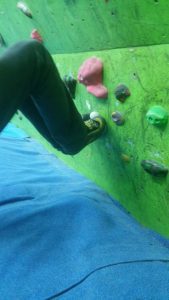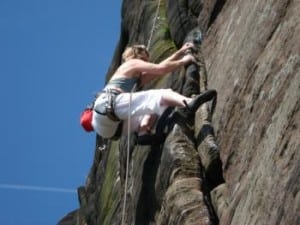Most new climbers have the misconception that climbing is about pulling yourself up the wall using mainly your arms, which is why they often get tired quickly and have poor technique.
Where and how you place your feet is far more important than your hands. The muscles of the legs are much stronger, and it is more  efficient to push with the legs than to pull with the arms, which is why it is important to use the toe area of the foot as this gives greater reach and balance. This is where a close fitting shoe enables footwork to be precise even on the smallest of holds.
efficient to push with the legs than to pull with the arms, which is why it is important to use the toe area of the foot as this gives greater reach and balance. This is where a close fitting shoe enables footwork to be precise even on the smallest of holds.
You must look for the obvious surface area of the hold and be in a good position to see your feet.This is no good unless you are able to move well on the wall.
Climbing is a dynamic activity. In order to move well, to flow up and across the wall you must develop the skill of moving your centre of gravity (around your tummy button), by transferring your weight onto one limb so you can release the pressure on one or more limbs so that you can move them.
Think of getting your nose over your toes – this transfers all your weight onto one foot so you can move the other foot.
You may also find that there often isn’t a foothold where you want one and beginners are often seen in contorted positions trying to get their foot onto the next hold. A simple solution is to use an intermediary technique, a smear, by applying pressure to the big toe area of one foot against the wall, keeping it horizontal in order to move the other foot to a better hold or do a foot swap – the tablecloth, the bunny hop, the dead point, the creep and the share to name but a few…

Choosing a climb at an indoor wall isn’t just about finding the climb and knowing the grade but choosing a route that is suitable. It is always best to start on easier climbs in order to warm-up the body to prevent injury and prepare the body. Warm-up routes are a good opportunity for the climber to concentrate on specific techniques on easier terrain such as good footwork, straight arm technique, twisting the body and pushing with the legs.
It is often the case that climbers choose climbs that are too difficult for them which means more time is spent hanging on the rope than developing their technique. Obviously climbers need to push themselves in order to improve, but unless they have good technique to begin with, their climbing will plateau and they won’t know why. If you feel you have plateaued you can always try an improvers coaching course